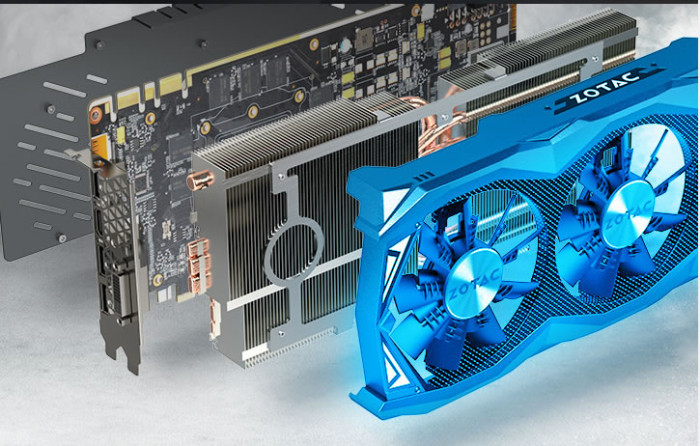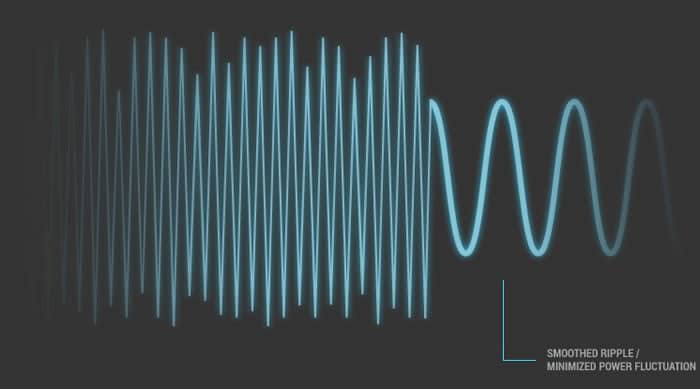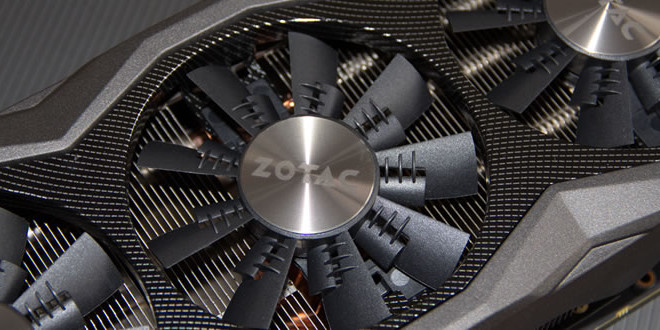Features
IceStorm

The cooling system on the Zotac GTX 980 Ti AMP! Extreme is called IceStorm. It is actually really massive (which we will see later) and comes with copper heat pipes and tightly packed aluminum fins to haul the heat away.
EKO-fans

The fans on the big cooler are called EKO-fans. According to Zotac they reduce air-resistance and increase airflow 30% compared to regular fans. They also decrease the dead-spot. Unfortunately we cannot verify this claim so you have to trust Zotac on this. Each big fan-blad also has a small extra blade on them. The small extra blades concentrate the airflow inwards increasing the air pressure 15% compared to regular fans, again not something we can test. The sum of these features though is lower temperatures and lower noise level, something we will be able to measure later.
Power Boost

The AMP! Extreme and the AMP! Omega cards are the only AMP! cards to come with “Power Boost”. Power Boost reduces ripple noise and minimizes power fluctuations. This is extra important for a card that is so aggressively overclocked right out of the box.
 Bjorn3D.com Bjorn3d.com – Satisfying Your Daily Tech Cravings Since 1996
Bjorn3D.com Bjorn3d.com – Satisfying Your Daily Tech Cravings Since 1996









How are you providing SLI results with a slower card in the pool? The Zotac clocks down to match the slower card to create equal performance. Essentially you posted results of the eVga card in SLI mode, not the Zotac. Also, the system you are benching on appears to be gen 2 not gen 3 pcie. You’re not getting the full 40 lanes out the Zotac… I assume these things will have an effect on your test results, no? i have this Zotac card and feel with the configuration and testing method you didn’t do it justice, it’s my first Zotac, coming from eVga 780 then 980’s all in SLI and find the new AMP Extreme a mind blowing experience. Extremely curious to see a what a “real” real-world test of two AMP! Extremes running in SLI with full gen 3 support active.
Well, until I get two of these cards to play with any SLI-tests will be affected by the difference in clockspeed. That said I could follow the clock speed in GPU-Z and each card was actually running at their relative speeds so it doesn’t seem it is clocking down – however it needs to be in sync so yes, we do get a bit slower SLI-results than we could get. The SLI numbers though is more to show what SLi can do for you. you are correct that I am rocking on an older gen mobo/CPU which I noted in my test-rig info and I am in the process of swapping everything out for Skylake the coming days so unless Zotac needs the card back ASAP i hope to get some new SLi-testing in during next week.
I just picked up a Skylake i7-6700K and the ASUS Z710 Deluxe (http://www.asus.com/US/Motherboards/Z170-DELUXE/) and will instalkl everything and then do some SLI-testing to see if the scaling changes.
Might be powerful, but I don’t trust Zotac 😛
Zotac is a more reliable edition compared to the plain but you’ll never get anything special and you’re likely to pay more. Then again if you’re looking for a more stable version of a unit where the special things like the 20th edition 980 for example mean nothing, zotac is the way to go.
I’ve tested a bunch of Zotac cards and their AMP! edition cards always worked well and provided nice overclocking featrures and good cooling. Still, even the “reference” cards of the 980 Ti overclock well so in the end you have to see how much you value factory overclocking and different coolers.
A fan of Zotac. They get the most out of their GPU’s but as a result, suffer limited longevity. I’ve had 2 of their cards die on me, roughly as I was just about to upgrade to the next version. Meanwhile all stock frequency cards I have from other brands (as far back as GeForce3) live to this day. On most cards the fans will wear out after about 3-4 years of regular use. In Zotac cards the GPU has a similar lifespan, which shouldn’t be an issue if you’re chasing high frequencies and tend to upgrade often.
May as well buy reference card
At that price I’d rather get a FuryX…